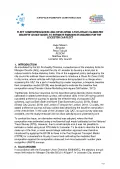-
Past ETC Papers

Browse, search and view papers from the past AET Conferences.
-
Members' Area

AET promotes networking and exchange of ideas, information and opportunities amongst members.
Conference Papers 2020
Online
ETC Conference Papers 2020
A Novel Two-stage Fleet Composition Model to Estimate Emission Standard Categories of the Leicester Car Fleet
Seminar
Day 2 (10 Sep 2020), Session 4, Modelling Fleets and Aspects of Electric Vehicle Rollout, 10:00 - 12:00
Status
Accepted, documents submitted
Submitted by / Abstract owner
Reza Tolouei
Authors
Hugo Nilsson (AECOM)
Reza Tolouei (AECOM)
Matthew Mace (Leicester City Council)
Short abstract
As a result of the lack of survey data, a novel two-stage calibrated logit choice model was developed to predict fleet composition in association with an air quality modelling study for the city of Leicester
Abstract
As mandated by the EU Air Quality Directive, exceedances of the statutory limits for Nitrogen Dioxide (NO2) required the city of Leicester in the UK to develop a local plan to reduce levels to below statutory limits. One of the suggested policy packages by the city council to address these exceedances was to introduce a Clean Air Zone (CAZ) in city centre, where vehicles with high emission are subject to a charge when accessing the CAZ. One of the key modelling challenges in assessing the impact of such policy packages is to understand travellers’ behavioural response to charging, which includes, together with various other responses, upgrading their vehicle.
Traditionally, behaviour response can be described using discrete choice models calibrated on stated preference surveys. Crucially, the stated preference surveys will also collect data describing the baseline composition of the vehicle fleet, which is a key modelling requirement. In the case of the Leicester City CAZ, no such survey data was available, and the study timescale did not allow specifying and undertaking one.
To combat this issue, an alternative method was adopted using Discrete Choice Modelling techniques, where a bespoke Baseline Fleet Composition Model (BFCM) was estimated using a multinomial logit model calibrated on the National Travel Survey (NTS). However, due to lack of sufficient and representative sample size, it was not possible to estimate a model using local NTS data for Leicester, where the local fleet composition is expected to be different from the national fleet represented within the NTS data. To be able to describe the local make-up of the fleet, a novel method was developed where a second stage calibration was introduced to adjust the parameters of the NTS-calibrated BFCM using data from Automatic Number Plate Recognition (ANPR) surveys.
Data from the NTS was used for the first stage of the calibration as this data set records a wealth of variables including trip volumes and characteristics, demographic characteristics, vehicle characteristics, fuel type, and year of registration. The following five emission groups were defined and used as choice alternative within BFCM:
• Compliant petrol vehicles
• Compliant diesel vehicles
• Non-compliant petrol vehicles
• Non-compliant diesel vehicles
• Vehicles with any other fuel type
The independent variables were chosen as candidates based on their indicative predictive power and on the requirement of being represented in LLITM for the second stage calibration. The final selected predictors were:
• trip distance (km) as a continuous variable;
• household income as a discrete variable (low, medium or high); and
• trip purpose as a discrete variable (commute, business or other).
The NTS-calibrated model proved to have a good degree of fit with most of the 24 estimated parameters showing statistical significance. A model diagnosis exercise was carried out by applying it to segments of the calibration data set to assess its predictive power among variations in the independent variables. Segments were formed by combining the three purposes and income groups, along with 10 discrete distance groups. The diagnosis tests demonstrated that the model had significant predictive power, with few incorrect predictions across all segments.
The NTS-calibrated model was subsequently applied to the demand matrices within the LLITM highway assignment model and compared against ANPR data across 32 locations on the Leicester road network. It was found that the stage one calibrated model predicted some of the variation in fleet composition, owing to the assumed variation in trip purpose and distance, along with household income among the trips using different links.
However, there was a clear systematic difference between modelled and observed patterns reflecting the local variation in fleet composition around Leicester compared with the fleet at a national level. For example, the NTS-calibrated model consistently overestimated the proportion of compliant petrol cars. These biases were corrected by introducing a second stage calibration, where a set of alternative-specific constants were introduced to the model. Following the second stage calibration, the BFCM fleet predictions aligned closely with the observed fleet composition in the ANPR data. Hence, the BFCM was deemed fit-for-purpose and applied to estimate the fleet composition of the baseline scenarios within the broader CAZ modelling exercise.
The novel two-stage modelling technique introduced in this paper can be used across similar studies where, due to various reasons, a targeted Stated Preference data is not available to draw on for modelling the composition of vehicle fleet, which is required as the basis of forecasting travellers’ behavioural response to charging.
Programme committee
Transport Models
Documents:

Association For
European Transport
Forester House
Doctors Lane
Henley-in-Arden
Warwickshire, UK
B95 5AW
+44 (0) 15 64 793552
VAT number: 710 1866 64
Conference Supporters & Endorsers




Legal Entity
The Association for European Transport is registered as an Association ('vereniging') with the Chamber of Commerce for Haaglanden in The Netherlands under company number 27170096.
Built on Zenario




